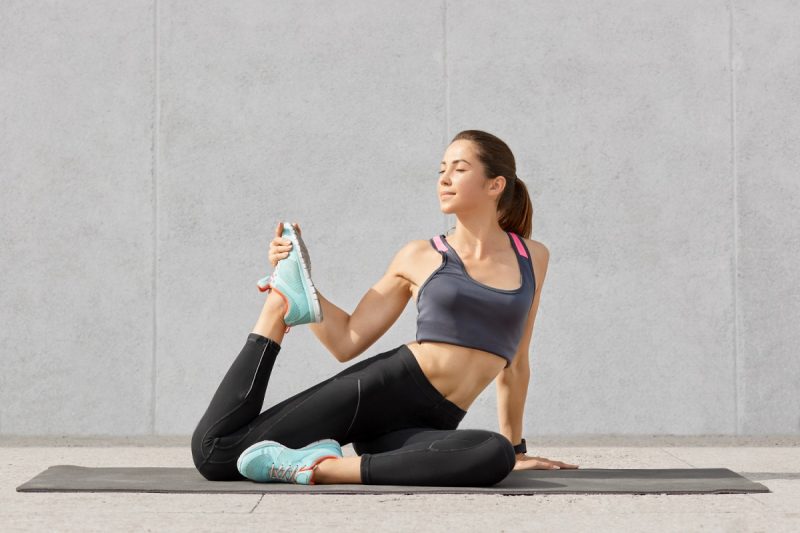Stretching is a crucial fitness factor. It enhances body posture, decreases stress and pain, plus much more. The neck, triceps, quads, as well as hamstrings, are famous muscle groups that are easy to target. While doing exercises, make sure you use a proper method plus form to gain maximum benefits.
Benefits
It provides a multitude of benefits:
Boost Flexibility
Doing it on an everyday basis enhances flexibility plus delays mobility decline that occurs with age. It helps individuals who live a sedentary lifestyle because they can do their daily tasks with ease.
Prevents/Fights Back Pain
Routine stretch therapy prevents back pain in the future. It decreases muscle stress plus makes back muscles strong.
Improves Blood Circulation
It enhances blood circulation to muscles. Blood vessels near the targeted muscle get wide and the heart pumps more blood. It minimizes soreness as well as recovery time.
Improves Sports Performance
Both dynamic plus static stretches enhance motion range. But static stretches are typically reserved for after workouts. Dynamic ones are proven to prepare muscles for daily activity. It boosts performance in an athletic event.
Makes Body Posture Better
Stress and tightness pull the spine into positions that put tension on your neck, back, plus core muscles. One research proves that routine stretching along with core strengthening exercises can enhance bad alignment and posture.
Induce Relaxation
Stretching in the morning relieves tension from sleeping the night before.
Static stretches activate the parasympathetic nervous system. It induces feelings of relaxation as well as alleviates stress.
Exercises
Consider these exercises to target diverse regions of your body:
Sciatica and Piriformis
This concept curbs plus prevents hip and lower back pain from piriformis syndrome and sciatica. A few examples include standing hamstring, glute, etc.
Lower Back
Working your lower back mainly targets the regions that cause lower back pain. It prevents injury as well as enhances mobility. You can choose Cat-Cow, Seated Butterfly, Spinal Twist, plus Child’s Pose. But try to do them carefully as well as gradually.
Hip Flexor
If you have tight hips, hip flexors are ideal for you. Relaxing hip muscles and upper thighs ensures proper movement plus prevents the risk of injury. Best hip flexor exercises include seated butterfly, basic bridge, reclined hip, as well as standing lunge.
Calf
Calf pose enhances short-term motion range and decreases the risk of injuring calf muscles while walking or standing. Few individuals do them as a cool-down or warm-up after or before yoga, cardio exercise, lower-body workout, or standalone health activity.
Cobra Pose
Cobra pose is another great exercise that can open up as well as stretch abs, chest, shoulders, and neck muscles.
Tips
The following tips will keep you safe:
Do Not Consider it as a Warmup
Before stretching, warm up your body with light walking, low-intensity biking, or jogging for nearly 5 to 10 minutes. But avoid it before field activities or other intense activities. One research shows that stretching instantly before any event declines hamstring strength.
Do Not Do Beyond Your Comfort Level
If you feel that the area hurts, stop that until you feel good again.
Do Not Overperform
Stretching puts stress on the body. For example, using similar muscle groups numerous times a day results in damage.
Pay Close Attention to Posture
Good posture enhances flexibility and decreases the risk of injury when there are tight muscles.
Focus on Main Muscle Groups
Focus on major muscle groups like hips, shoulders, neck, calves, thighs, plus lower back. Ensure you focus on both sides.
Do Not Bounce
Bouncing while you stretch injures muscles and leads to muscle tightness. So, do it smoothly without bouncing.
Breathe
While stretching, breathe comfortably. But avoid holding your breath.
Do Not Stretch in these Cases
Avoid this if you have:
- Nagging or chronic injury
- Existing or acute injury
- Physical restrictions that prevent you from performing stretching exercises properly.
Conclusion:
Stretch therapy is a crucial part of your fitness plus health routine. Traditionally, it has been included as a part of recovery and training programs. From enhanced blood flow to boosted flexibility, there are numerous advantages. But make sure you begin gradually and listen to your body to avoid injuries.

